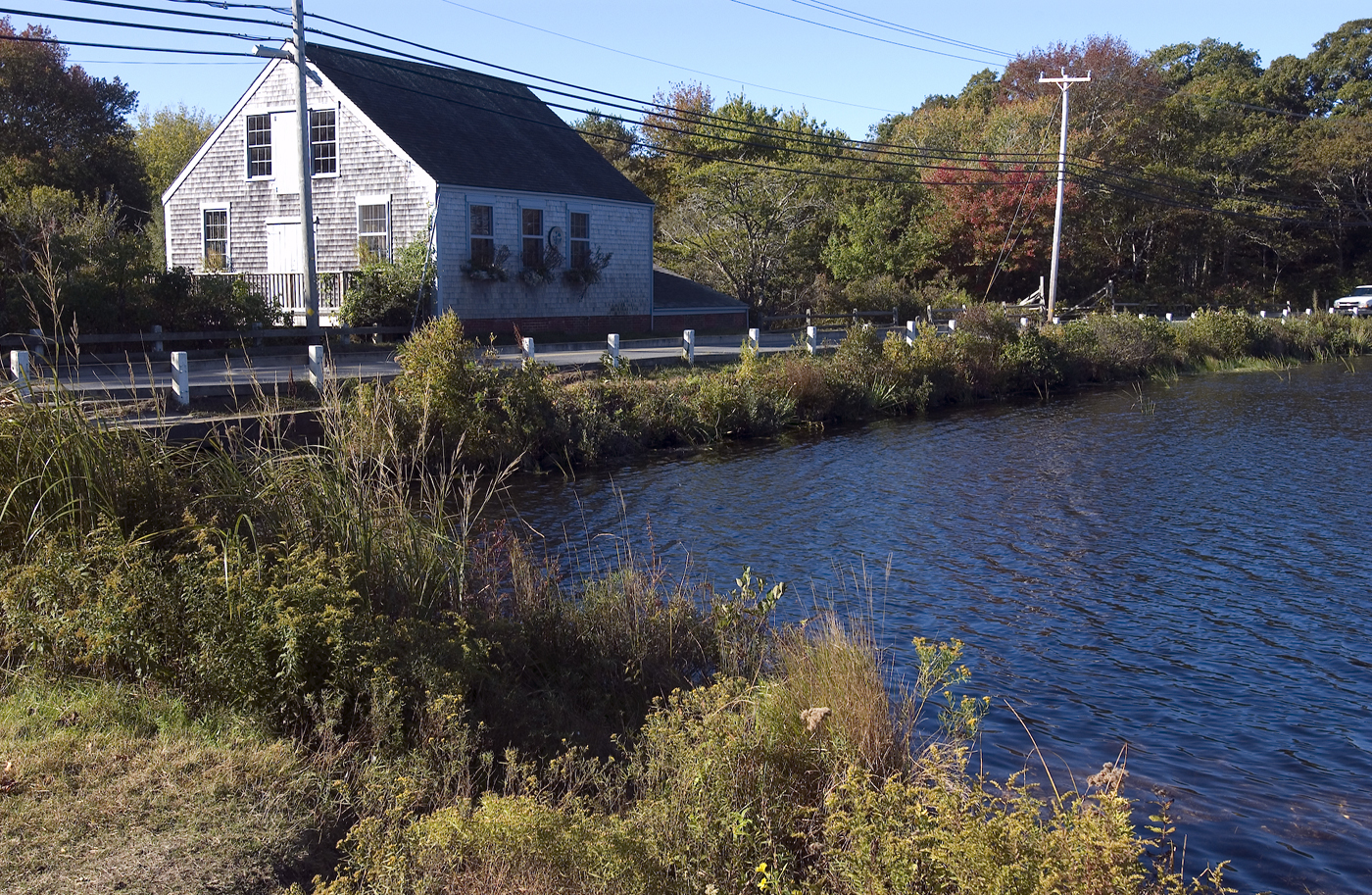To dredge or not to dredge? That is the question currently being bandied about in West Tisbury.
A specially-appointed research committee has split over whether to dredge Mill Pond, the historic man-made pond that graces the entrance to town on the Edgartown-West Tisbury Road adjacent to the police station. Two of the committee members, Bob Woodruff and Craig Saunders, believe that dredging is necessary to prevent the pond from drying up and disappearing forever.
But a third member, Kent Healy, is vehemently opposed to dredging and believes the pond can be preserved with simpler and less costly measures such as pulling weeds or increasing the height of the dam on the southern edge of the pond.
The split in the Mill Pond committee mirrors a growing fissure among town officials who either support or oppose the idea of dredging the freshwater pond. The town historic district commission supports dredging, believing it will preserve a town landmark and one of the earliest examples of Island industry.
Others question the need for a project that could cost up to $200,000 when there is no real proof the pond is in peril.
Mill Pond covers approximately 2.5 acres and is fed by the Mill Brook, which originates north and west of the pond basin. The primary flow of the brook is diverted through a man-made structure into two separate flows just south of Panhandle Road. The pond has become quite shallow in recent years, and currently has an average depth of around 1.7 feet.
The debate over dredging has gone on for some time, and it came to a head at Wednesday’s selectmen meeting when Mr. Woodruff and Mr. Saunders presented their final report to the board.
Among other things, the four-page report recommends that two acres of the pond be dredged to a depth of three feet.
The report stands on a 2006 study by Aquatic Control Technology that makes several recommendations for repairing the pond, including dredging, hydro-raking and weed-pulling. In their report Mr. Woodruff and Mr. Saunders chose the dredge option, which they estimate will cost between $170,000 and $200,000.
Mr. Woodruff said for now the committee is only asking selectmen to endorse an application to the town Community Preservation Committee for $50,000, to cover the cost of engineering and permitting.
But the discussion soon strayed beyond this and town leaders began to stake out their own positions on the issue.
Selectman Jeffrey (Skipper) Manter said the pond has showed signs of improving in recent years, and he questioned whether the town should endorse a costly solution.
“I’m not 100 per cent in favor of spending this amount of money . . . we’re talking about $200,000, give or take, and that’s just more than my poor little tummy can swallow if we’re using taxpayer money. Nobody has enjoyed that pond more than me, ever since I was a little fellow, but the weeds have subsided, and for whatever reason more of the pond is exposed,” Mr. Manter said.
Then Mr. Healy took his turn, reading from a prepared statement that among other things criticized his fellow committee members for making public statements that he had resigned from the committee — when in fact he had not. He also said the committee has never posted meetings, recorded minutes or even held a proper meeting with all three members present.
And Mr. Healy said he believes dredging would do more harm than good.
“Dredging the pond, [with either] hydraulic or mechanical equipment, would disrupt the existing habitat, make a mess downstream, interrupt flow to Maley’s Pond fire hydrant, and consume diesel fuel while emitting noxious oxides into the environment,” he said.
Michael Colaneri, a member of the board of assessors and town affordable housing committee, said he didn’t think there was a lot of public support for dredging.
“I’m not seeing a lot of letters and I don’t hear a lot of chitchat about spending a fortune down there on the Mill Pond . . . and there is nothing scientific saying this needs to be done. Where is the data?” he said.
Mr. Woodruff said there is plenty of data, beginning with the 2006 report from Aquatic Control Technology.
“Dredging is the most recommended long-term management alternative for the pond, and the only technique that will address, at least in part, both the excessive growth of rooted vegetation and the significant accumulation of sediment. Dredging is certainly the only technique that can appreciably restore the pond’s water depths,” the report states.
But the report does not endorse one single technique or course of action.
In a conversation with the Gazette before Wednesday’s meeting, Mr. Woodruff said he strongly believes dredging is the best way to prevent the pond from drying up. “The pond is not capable of repairing itself; we have to do something,” he said.
He said the pond is home to a number or rare plant and animal species, including the brook lamprey and several species of moth. It also home to amphibians, reptiles and mammals, including otters and muskrats. Just as important, Mr. Woodruff said, the pond is part of the fabric of the town.
“If you ask a lot of people what they think about when they picture West Tisbury, their thoughts turn immediately to Mill Pond. It’s part of our heritage and our history,” he said.
In a letter to the selectmen, Annie Fisher, chairman of the historic district, offered support for dredging, noting that Mill Pond was designated as one of several historic resources by a town meeting vote in 1982. As far back as the 1600s, people from across the Island used the Mill Pond to grind corn, she said.
“Combined with the village center, the mill and Mill Pond offer to residents and tourists alike a scenic continuity and identity to West Tisbury and should be preserved and maintained as such,” Ms. Fisher wrote.
On Wednesday, after nearly an hour of emotional debate, selectmen agreed they could not accept the report from the Mill Pond committee because it was drafted without the participation of Mr. Healy, and therefore did not represent the committee as a whole.
Selectman and board chairman Diane Powers asked the three members to meet and return with a report that included all points of view.
“You can even agree to disagree. Just produce a report from the [entire committee],” she said.
The committee will return to the selectmen on Oct. 28.









Comments (1)
Comments
Comment policy »